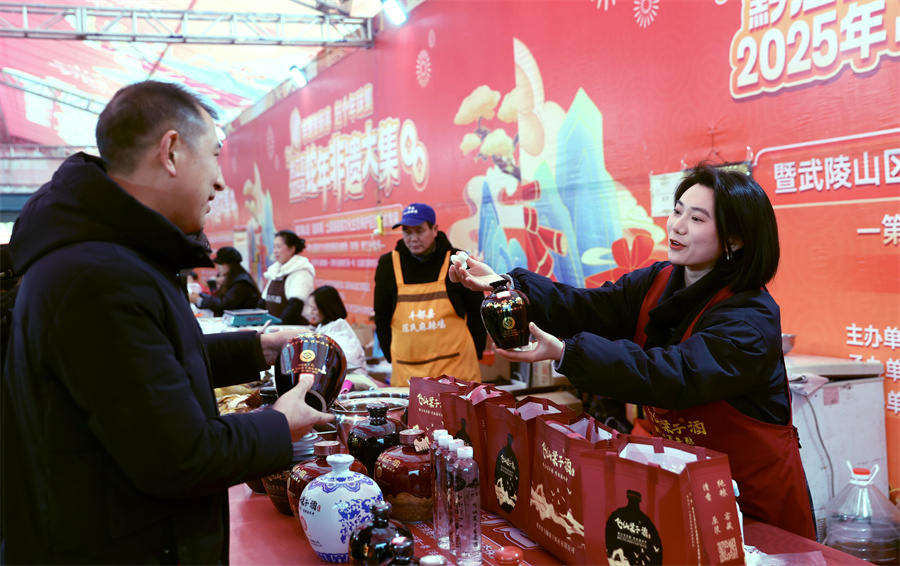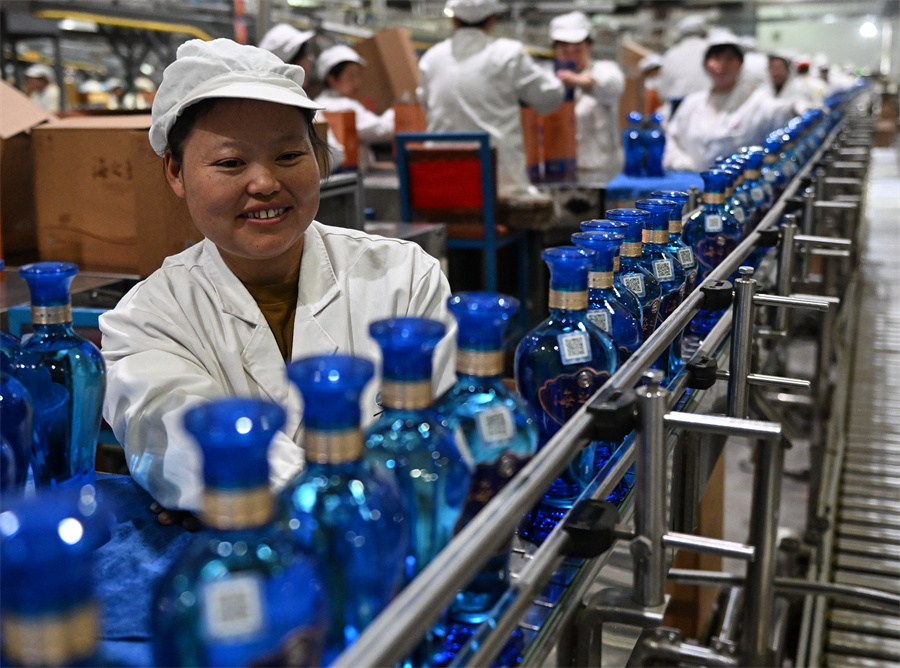
A customer checks out liquor products at a market in Chongqing in January. [YANG MIN/FOR CHINA DAILY]
After years of expansion, China's liquor industry is shifting from rapid growth to a more rational and balanced market, as brands adapt to changing consumer preferences and market saturation. Cost-efficiency and international expansion have emerged as key drivers of future growth, according to industry reports and experts.
The China Alcoholic Drinks Association reported that the country's liquor market, including imported spirits, reached a nearly 2 trillion yuan ($275.24 billion) scale, with 9.4 million registered enterprises in 2024.
The report, titled Development of the Liquor Industry in China 2024, highlighted the deflation of the long-standing market bubble, giving way to a more rational and sustainable business environment that prioritizes quality over volume.
As the market matures, brands are highlighting cost-effectiveness, international expansion and targeting younger consumers, said the report.
Due to challenges such as high inventory levels, price fluctuations and changing consumer behavior, industry leaders are adjusting their strategies.
According to a Mintel report, liquor and beer continue to dominate the alcoholic beverage market, accounting for over 90 percent of total sales in recent years.
"Liquor brands have been continuously innovating in digital marketing to adapt to market shifts and consumer behavior changes," said Marta Zhang, senior analyst, China insights at Mintel.
CADA forecasted that 2025 will be a turning point for the industry and encouraged players in the sector to launch initiatives to balance supply and demand, leverage digital tools and explore international opportunities, according to the report.
Leading liquor companies such as Kweichow Moutai Group, Shunxin Agriculture, Swellfun and Huangtai Liquor have demonstrated resilience, reporting stable or improving financial results.
As the market leader, Kweichow Moutai continues to post robust financial results. The company is projected to have achieved 173.8 billion yuan in revenue for 2024, marking a 15.44 percent year-on-year increase.
Its net profit is expected to have reached 85.7 billion yuan, up 14.67 percent, reinforcing strong demand for high-end liquor among premium consumers.
Swellfun, a subsidiary of Diageo, has avoided excess inventory by shifting from a traditional stocking model to a controlled supply strategy. This has helped stabilize its pricing and maintain its premium brand value. Swellfun is expected to post 5.22 billion yuan in revenue for 2024, a 5 percent year-on-year increase, with net profit rising 6 percent to 1.341 billion yuan.
Shunxin Agriculture, parent company of Niulanshan Erguotou, is expected to report a net profit of 1.9 billion to 2.6 billion yuan for 2024, a major turnaround from its 2.96 billion yuan loss in the previous year. The recovery is attributed to steady growth in its liquor business and an improved pork division.
Similarly, Huangtai Liquor forecasts a net profit of 250 million yuan to 330 million yuan for 2024, up 266 percent to 319 percent, reinforcing the importance of strong brand management and strategic adaptation in a competitive market.
While top players maintain stability, mid-tier and smaller liquor brands are under pressure from intensified competition, inventory challenges and changing consumption habits.
Shede Spirits anticipates a net profit of 320 million yuan to 420 million yuan, marking a 76.29-81.93 percent decline year-on-year, but forecasts a recovery in 2025.
Qinghai Huzhu TianYouDe Highland Barley Spirit expects a 50-60 percent drop in net profit. Jiugui Liquor is projected to see a 97.26-98.17 percent decline, with profits between 10 million yuan and 15 million yuan.
Cai Xuefei, a liquor industry expert, forecasted the year 2025 will be a pivotal year for deep structural adjustments. He said that rational development has become an industry consensus, with factors, such as government stimulus policies, price corrections and inventory reductions, expected to position the sector for recovery in the coming years.
Industry experts said that liquor brands must adapt to evolving consumer preferences. Younger generations are increasingly exploring lower alcohol content, innovative packaging and new drinking experiences.
At the same time, e-commerce and digital marketing are playing a more prominent role in shaping consumer behavior, making an enhanced online presence crucial for brands.

Employees work on a liquor production line in Suqian, Jiangsu province, in November.[Photo/Xinhua]
The Mintel report has found that domestic liquor is considered the most culturally rich category of alcoholic beverages. Consumers with higher incomes generally have a stronger recognition of their cultural heritage.
"Brands should enhance interaction to strengthen the cultural attributes of domestic liquor," according to Mintel.
Meanwhile, international expansion remains a key growth avenue for many liquor brands in China.
Data from the China Chamber of Commerce of Import and Export of Foodstuffs, Native Produce & Animal By-products show that China's total alcohol export value reached $1.9 billion in 2024, up 6 percent year-on-year. Total export volume hit 750 million liters, up 5.1 percent year-on-year.
Liquor accounted for 51 percent of total alcohol export value, reaching $970 million — a 20.4 percent increase.
Export volume for liquor rose 6.3 percent to 16.42 million liters, with an average price of $59 per liter, up 13.3 percent.
Analyst Cai Xuefei said that 2024 marked the inaugural year of Chinese liquor's "going global", urging brands to explore international markets for long-term growth.